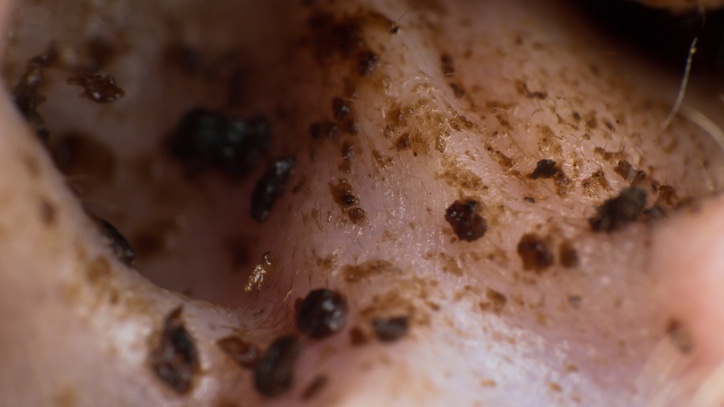How to clean cat ears: Help avoid mites and infection
Kitties love to self-groom but you still need to know how to clean cat ears to help avoid many potential problems

Knowing how to clean cat ears is important to your kitties' overall health. A check of their ears has many benefits including giving you an early warning of any potential problems, such as ear infections or ear mites, before they get worse.
Before you start reaching for the Q-tips, however, it's equally crucial that you clean cat ears correctly (and that includes putting those Q-tips back in the box!).
There are also some signs to watch out for when cleaning, as well as ways to tell when a cat's ears are perfectly healthy.
Do you need to clean cat ears?
It's true to say that cats are very good at self-grooming. They are fastidious about cleanliness and seem to take immense pride in their appearance. Indeed, if you've ever wondered, "do cats need baths?", the answer is no, unless absolutely necessary!
Even so, kitties don't find it easy to clean inside their ears. It often means they become rather dirty and this is where your help will prove to be invaluable.
Your main task is to get rid of any gunk and debris and, if you have a cat which loves to venture outdoors, then you'll find this builds up far quicker than with house cats but you should tackle both with the same thoroughness.
It's a good idea to get into a routine of at least looking inside your cat's ear each week. If you do this from a very early age, kitties will soon become used to this kind of intrusion.
Get the best advice, tips and top tech for your beloved Pets
But what's the point of removing dirt? Well, aside from looking unsightly, too much debris, wax and dirt can cause ear infections in cats. Regular cleaning also means you're going to be looking more closely at your feline friend and this will help in the early detection of ear mites in cats.
If you leave them alone and miss such signs, life can very quickly become uncomfortable for your pet.

What to use to clean cat ears
You don't really need much in the way of specialized equipment to clean cat ears. Just grab some moist cotton gauze pads or cotton wood balls and purchase some cat ear cleaner.
Recommended products include Vetoquinol's Ear Cleansing Solution and Virbac's Epiotic Advanced Ear Cleaner, both of which should be effective in leaving your cat's ears in tip-top condition.
Vetoquinol's Ear Cleansing Solution
This is a gentle cleanser for a cat's external ear canal which not only cleans but deodorizes, dries and acidifies, too, helping to prevent your moggy from developing irritating ear infections.
Virbac Epiotic Advanced Ear Cleaner
Intended for routine ear cleaning, this effective cleanser can be applied liberally to remove excessive wax and debris. It boasts a low pH so it can be used with other ear-related solutions.
How to clean cat ears: Step-by-step
The process itself is straightforward enough but how easy it will be depends on how your cat will react:
- First, gently pick up your cat and perhaps offer a treat while stroking them.
- Next, take a good look inside the ear and look for anything unusual such as discharge, too much wax, redness and debris. It's a good idea to put your nose close to each ear and smell for terrible odors. If you detect any, it's worth seeking a vet's advice.
- Otherwise, gently hold the tip of your cat's ear flap and pull it back, allowing you to apply the solution while being careful not to allow the bottle to touch the skin (always check the bottle for instructions because the method of application can vary).
- You can then massage the outside of the ear and grab a moist cotton gauze or ball using it to carefully wipe any dirt away from the outer ear before drying. Avoid poking inside the ear canal itself and, if you fear your cat will start scratching you, wrap your moggy in a towel before starting the process.
What’s the black stuff in my cat’s ears?
If you spot any black or brown gunk in your cat's ears, then it's likely your cat has a problem with ear mites. What you're seeing is wax that has been created as a reaction to the mites mixed with blood, debris and even the mites themselves.
So is the answer to give a cat a flea bath? Not in this instance. Yes, you need to take action, but the best way forward at this point is to visit a vet and have them assess your cat and resolve the problem. That way, you can be sure your cat is being treated appropriately.

How do I tell if my cat has ear mites
Aside from spotting the black stuff, you should also take your cat to the vet if a cat's ears smell bad or there is too much ear wax. This is true, too, if a cat winces when you touch their ears or if you spot any poor skin and bald areas where a cat has been trying to remove hair. Mites are certainly bad news.
They can live for about two months and they constantly lay new eggs so your cat will end up getting stuck with these tiny creatures forever unless the problem is tackled. What's more, there's a risk that the mites will transfer to other pets.
Keeping ears clean will reduce the risk substantially but it's always best to seek expert advice in these circumstances. Just remember that a healthy cat's ear should always be pale pink in color.

David Crookes has been a journalist for almost 30 years and he has written for a host of magazines, newspapers, websites and books including the World of Animals Annual, BBC Earth, Live Science, The Independent and Tom’s Guide.
Born in England, he lives with two cats but he’s also keenly interested in the differences between the huge number of dog breeds – in fact, you can read many of his breed guides that he’s written in collaboration with vets here on PetsRadar.
With a lifelong passion for technology, too, he’s always on the lookout for useful devices that will allow people to keep their pets happier and healthier, and provide them more time to spend together.
David has a degree from Durham University, as well as postgraduate diploma in journalism from the University of Central Lancashire.


